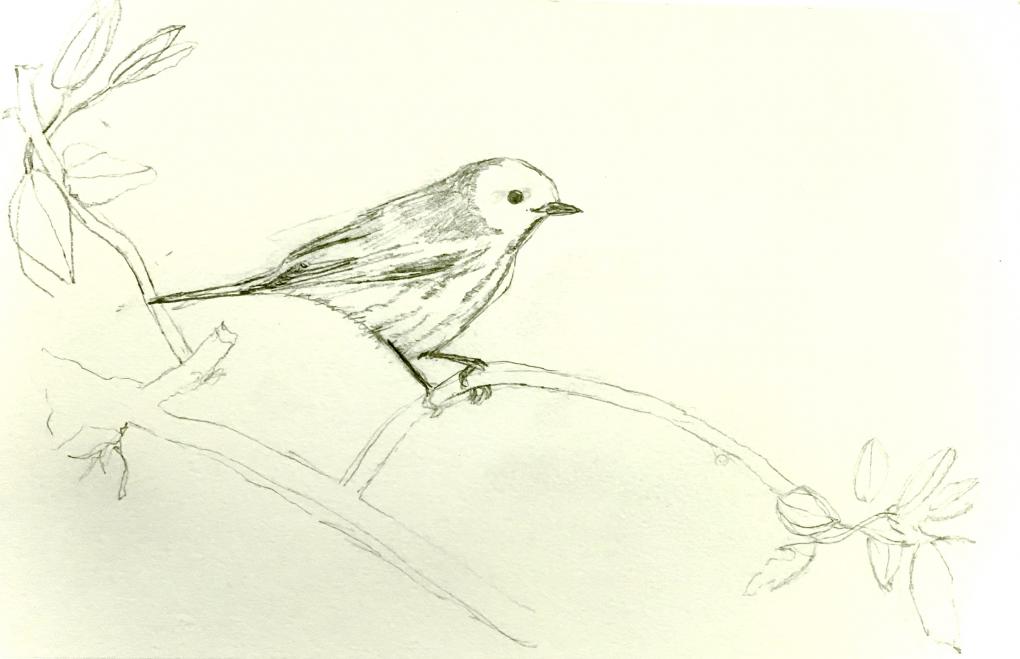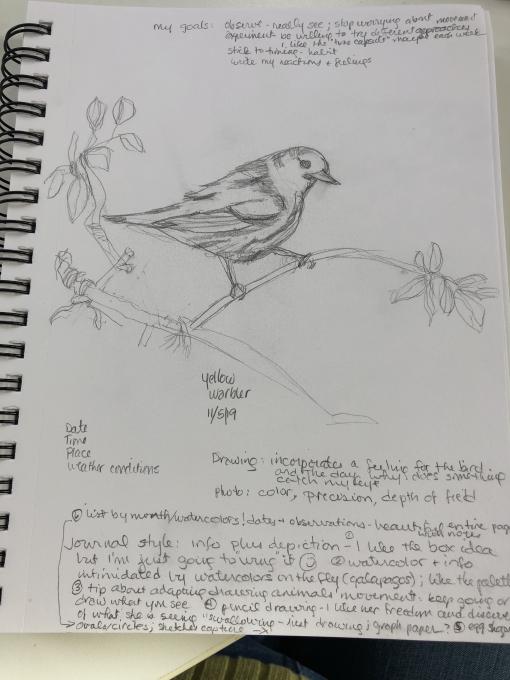The Cornell Lab Bird Academy › Discussion Groups › Nature Journaling and Field Sketching › Jump Right in!
-
 It sure is easier with the yellow warbler posed perfectly for me. The feathers were a real challenge becuse I wanted to study them later and learn the specific names of the different types of feathers. I wanted to try and get the different layers close to the correct position. I am so excited to learn how to draw and paint in nature.
I wouldn't have noticed the layers of feathers and where they are when the bird folds its wings. I also always thought of a yellow warbler as all yellow. Look at the rusty colored patterns and the white and black on the wing feathers. What a great surprise!
It sure is easier with the yellow warbler posed perfectly for me. The feathers were a real challenge becuse I wanted to study them later and learn the specific names of the different types of feathers. I wanted to try and get the different layers close to the correct position. I am so excited to learn how to draw and paint in nature.
I wouldn't have noticed the layers of feathers and where they are when the bird folds its wings. I also always thought of a yellow warbler as all yellow. Look at the rusty colored patterns and the white and black on the wing feathers. What a great surprise! -
 This is my first attempt at drawing in many years. I look forward to improving my sketching and developing a style to call my own.
I’ve enjoyed seeing everyone’s work.
This is my first attempt at drawing in many years. I look forward to improving my sketching and developing a style to call my own.
I’ve enjoyed seeing everyone’s work. -
 First sketch is attached. Using a photo is helpful in some ways - get more details because animal is not moving. You can take your time with the sketch. In nature you would have more of an issue with angle of sun, brightness of natural light, etc. I will need to practice and find the right pencil to work with and then perhaps go for color. Need to work on control of pencil as making sure I capture proportions of structures.
First sketch is attached. Using a photo is helpful in some ways - get more details because animal is not moving. You can take your time with the sketch. In nature you would have more of an issue with angle of sun, brightness of natural light, etc. I will need to practice and find the right pencil to work with and then perhaps go for color. Need to work on control of pencil as making sure I capture proportions of structures. -
Here is my finished sketch. I have not had a pencil in my hand since college, 1978, so I am happily not discouraged!! Was not ready for color and need to work on getting the details in. Concentrated more on sizing and spacing. Yay!

-
It was much harder than I thought. Trying to get the proportions correct and details. The details make the difference, I just don't feel I can begin to draw them
-
Drawing forced me to look at all the details which makes me more observant to journal. The detail of the feathers, the texture of them, & the fine breast streaks were very hard to try to capture. I haven’t used a ‘water brush’ before so I’ll have to master that too to do so.
 I hope to be more precise in painting those details though. It will be interesting to try this again at the end of the course.
I hope to be more precise in painting those details though. It will be interesting to try this again at the end of the course.
-

-
1. Drawing from the photo with pencil, then over that with ink felt comfortable, since I do that often. The painting part was hard. I find paint intimidating so instead of jumping right in, I got familiar with the Koi sketch box colours by painting and labeling them. It was my first time using a water brush and I found it difficult to control how much water was in the brush. 2. I like taking photos of nature because it is a very fast way to capture a moment and my camera easily reproduces colours. Drawing from a photo allows me to spend more time with the subjects, observing and reproducing. Drawing the yellow warbler helped me notice the colours of the different feather groups, the shape of the bird's beak, and how the bird positions his feet on his perch. I also payed closer attention to the brown of the branch, its texture and how the shadows fell on it. I noticed the shape, colour and vein pattern of the leaves. The time to observe and reproduce when drawing makes me notice more details in nature which make my nature journaling experience richer.

-
Started my sketch....some pro's and cons about photo's. Pro's: I found if I could not see the detail of a specific area I could magnify it, for instance the moss and lichens. The subject stays still, so, you can come back to it more than once to refine. And I noticed I had overlooked some items in the pic such as branches I neglected to add but saw them on a second glance. I could take time to see how the leaves overlapped. Con's: you focus too much on trying to recreate the picture in front of you instead of using it as a framework and adding your own talents and impressions to it. My first attempt is too "stiff" b/c I was too focused on "getting it right". I was also focused on the picture, overall, whereas in the field I would probably be more focused on the bird itself. Overall, I had too slow down, observe, think, try, erase and try again. It made me discipline my mind and body to slow down which is some of what I am looking for in this course. I have to attempt the bird next so I am not done and will come back tomorrow with a fresh eye. I appreciated everyone else's work so thank you all for being my muse.
-
Getting ready to do my first drawing and looking at all of yours is helping me decide what notebook, what media, how detailed and how much of the picture to do as some of you focused on the entire picture while others more on just the bird. I am thinking this is going to take more time rather than less.......
-
1. It felt good to draw again. I found it challenging to capture the round, stout shape of the bird. I liked getting the eye with the light in it. 2. I noticed the shading around the bird's neck and head - a little darker yellow than the rest of the bright yellow. would not have noticed it without drawing it.

-
I enjoyed drawing from the photo and found it easy. I noticed the details of the warbler more by drawing it than I would just looking at it. I think this makes a difference in nature journaling.

-
1.) I could not quit laughing. This is so much fun. The shape of the bird is most challenging. I think I really like drawing branches and leaves. 2.) I would have never noticed the bit of moss on the branch and the way the light sits on the branches and leaves. I have always been concentrating on the bird in the past. This is amazing.
-
 The bird's beauty and expression makes it easy to connect through the eyes down through the hand and pencil. What I learned and appreciated from drawing: the wing structure -- the layers of different feathers that make up the wing.
The bird's beauty and expression makes it easy to connect through the eyes down through the hand and pencil. What I learned and appreciated from drawing: the wing structure -- the layers of different feathers that make up the wing. -
 My daughter and I are doing this course together...looks like we forgot to answer the questions, but we did discuss them.
Drawing from a photo is much easier since it's not going to fly away any second;-) My daughter says the branch was the easy part. I find proportions are always challenging for me. We both noticed that by drawing/painting your subject that you become more familiar to it and notice more details. I think that you become more connected to it and more concerned about its welfare as well. So, nature journaling can make a significant different in how you see and interact with the world around you.
My daughter and I are doing this course together...looks like we forgot to answer the questions, but we did discuss them.
Drawing from a photo is much easier since it's not going to fly away any second;-) My daughter says the branch was the easy part. I find proportions are always challenging for me. We both noticed that by drawing/painting your subject that you become more familiar to it and notice more details. I think that you become more connected to it and more concerned about its welfare as well. So, nature journaling can make a significant different in how you see and interact with the world around you. -
 Hi all
Finally sat down to get started and tried to focus on shape and key features rather than stressing too much about precision. Quite pleased with how this turned out after maybe 30 minutes work given I have no art background and haven't sketched anything since high school about 30 years ago!
Hi all
Finally sat down to get started and tried to focus on shape and key features rather than stressing too much about precision. Quite pleased with how this turned out after maybe 30 minutes work given I have no art background and haven't sketched anything since high school about 30 years ago! -
I drew two warblers, because when I drew the first I accidentally brought up only part of the photo on the screen; when I realized there was more to it, I wanted to try to draw the whole picture. I drew the second bird faster than the first and tried the circle for head/circle for body idea one of the journalers in the first lesson demonstrated. Drawing the bird forced me to study it more closely and notice patterns, lines, and colors in the feathers that I hadn’t paid attention to. I found drawing it very difficult, especially getting the wing feathers right. One of the reasons I’m taking this course is to train myself to pay more attention to the natural world around me, so I’m very happy to see that even with this first lesson, I’m learning to look more carefully and to take pleasure in seeing all the detail that I’d initially missed.

-
 Spent days psyching myself up to do the drawing. Haven't put pencil to paper in years. Hoping this course motivates me. Looking forward to working with color. Have only ever used pencil. Have always been fascinated by drawings done by naturalists on expeditions of discovery centuries ago. Looking forward to learning how to work from nature.
Spent days psyching myself up to do the drawing. Haven't put pencil to paper in years. Hoping this course motivates me. Looking forward to working with color. Have only ever used pencil. Have always been fascinated by drawings done by naturalists on expeditions of discovery centuries ago. Looking forward to learning how to work from nature. -
I've always spent as much time as I could outside in nature, especially birding. Having retired, I decided to learn to draw/journal to compliment photographs I've taken and to record observations in a new and more detailed way. I've not drawn before but having studied photographs, it seemed like a natural exercise albeit an extremely difficult one for me. As noted by others, getting the proportions correct is a real challenge. I'm hoping lots of practice will lead to better accuracy. I don't think there was anything that I observed drawing that I wouldn't have otherwise noticed. Having said that, I'm not confident many details are rendered in a manner than indicates they were noticed. One of the advantages of drawing is that one could eliminate a stray twig or leaf partially blocking the bird. Also, I assume, with practice, it would be possible to better convey the essence of the bird in a way a photograph cannot.
 A good photograph will capture much more feather detail and color than a drawing; the proportions are right as well. This assumes, of course, good light, no awkward angles etc.
A good photograph will capture much more feather detail and color than a drawing; the proportions are right as well. This assumes, of course, good light, no awkward angles etc. -

-
I did spend a lot of time doing my drawing and wonder how I'll ever be able to capture a bird or animal that can move out in nature. And especially how I'll be able to capture it in watercolor. Also, I noticed in the earlier video that there are watercolor paintings on the front and back of journal pages. How can you use watercolor on both sides of the same paper and not mess up what's on the other side?
-
Well, it wasn't too hard.... the bird at least looks like a bird and pretty close to the photo... I had rouble with the black and brown stripes on the wings and body... I was growing tired. I think I lack perseverence. Martha
-
 Can't wait to see my "after" drawing! This exercise did motivate me to read more about yellow warblers and study other photos/drawings.
Can't wait to see my "after" drawing! This exercise did motivate me to read more about yellow warblers and study other photos/drawings. -
I found that getting the proportions of the bird’s form was the most challenging. I found myself wondering about structures I couldn’t see, like how the wing on the far side of the body was attached, because I felt like I couldn’t just end my drawing correctly at the edge of the bird without knowing how the physiology continued on the other non-visible side. I also found it difficult to convey the sense that the bird’s head was turned a bit toward the viewer. I was pretty happy overall with this first attempt, although after I photographed it I realized that the body was a bit too narrow horizontally. Looking forward to improving, especially Learning how to add color and shading in a way that conveys dimensionality and texture.

-

Read More:
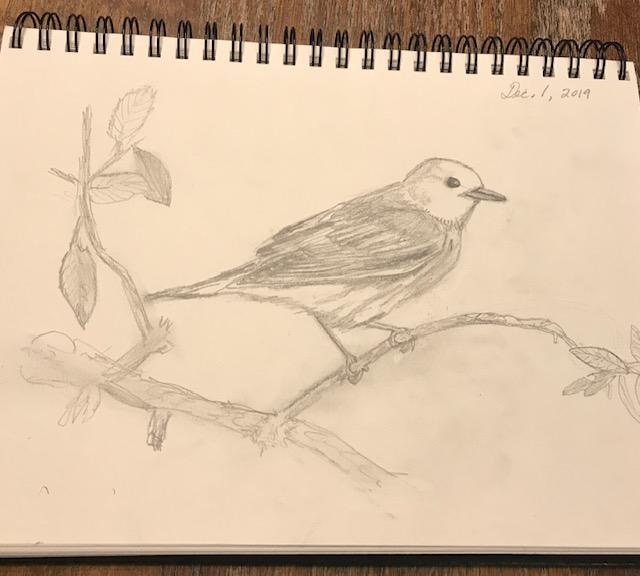 It sure is easier with the yellow warbler posed perfectly for me. The feathers were a real challenge becuse I wanted to study them later and learn the specific names of the different types of feathers. I wanted to try and get the different layers close to the correct position. I am so excited to learn how to draw and paint in nature.
I wouldn't have noticed the layers of feathers and where they are when the bird folds its wings. I also always thought of a yellow warbler as all yellow. Look at the rusty colored patterns and the white and black on the wing feathers. What a great surprise!
It sure is easier with the yellow warbler posed perfectly for me. The feathers were a real challenge becuse I wanted to study them later and learn the specific names of the different types of feathers. I wanted to try and get the different layers close to the correct position. I am so excited to learn how to draw and paint in nature.
I wouldn't have noticed the layers of feathers and where they are when the bird folds its wings. I also always thought of a yellow warbler as all yellow. Look at the rusty colored patterns and the white and black on the wing feathers. What a great surprise!  This is my first attempt at drawing in many years. I look forward to improving my sketching and developing a style to call my own.
I’ve enjoyed seeing everyone’s work.
This is my first attempt at drawing in many years. I look forward to improving my sketching and developing a style to call my own.
I’ve enjoyed seeing everyone’s work. 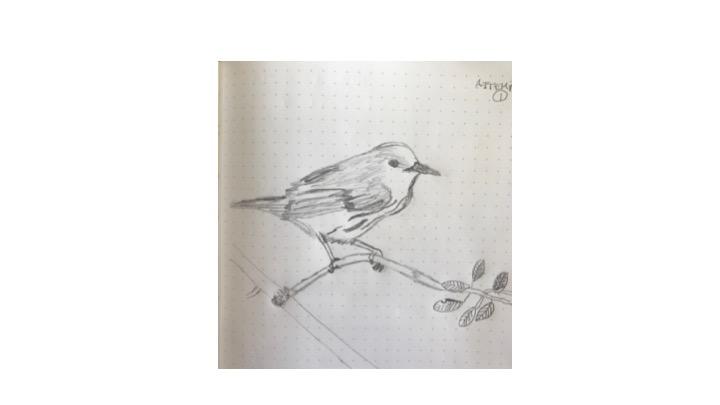 First sketch is attached. Using a photo is helpful in some ways - get more details because animal is not moving. You can take your time with the sketch. In nature you would have more of an issue with angle of sun, brightness of natural light, etc. I will need to practice and find the right pencil to work with and then perhaps go for color. Need to work on control of pencil as making sure I capture proportions of structures.
First sketch is attached. Using a photo is helpful in some ways - get more details because animal is not moving. You can take your time with the sketch. In nature you would have more of an issue with angle of sun, brightness of natural light, etc. I will need to practice and find the right pencil to work with and then perhaps go for color. Need to work on control of pencil as making sure I capture proportions of structures. 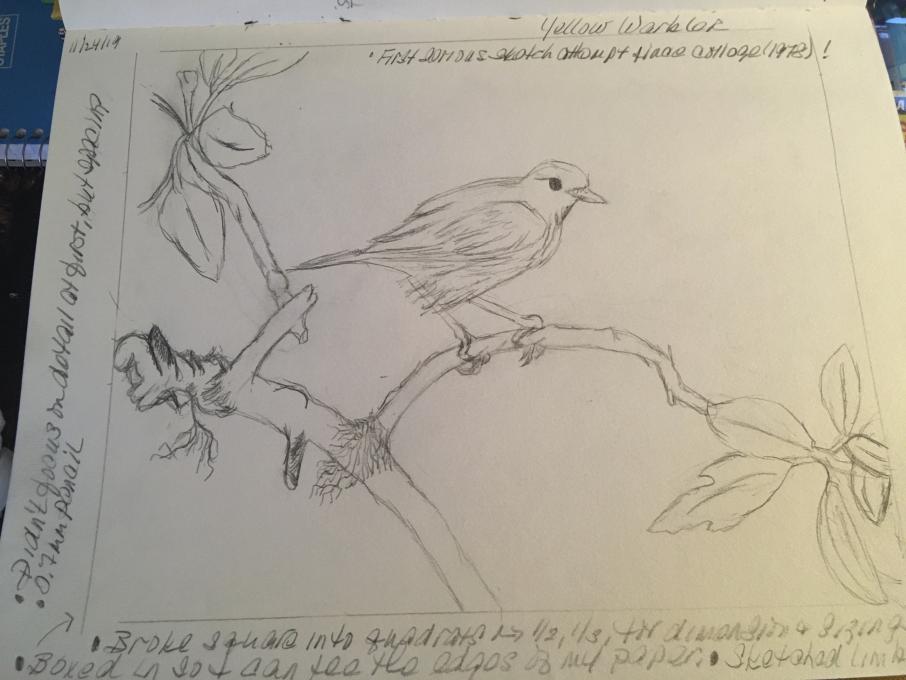
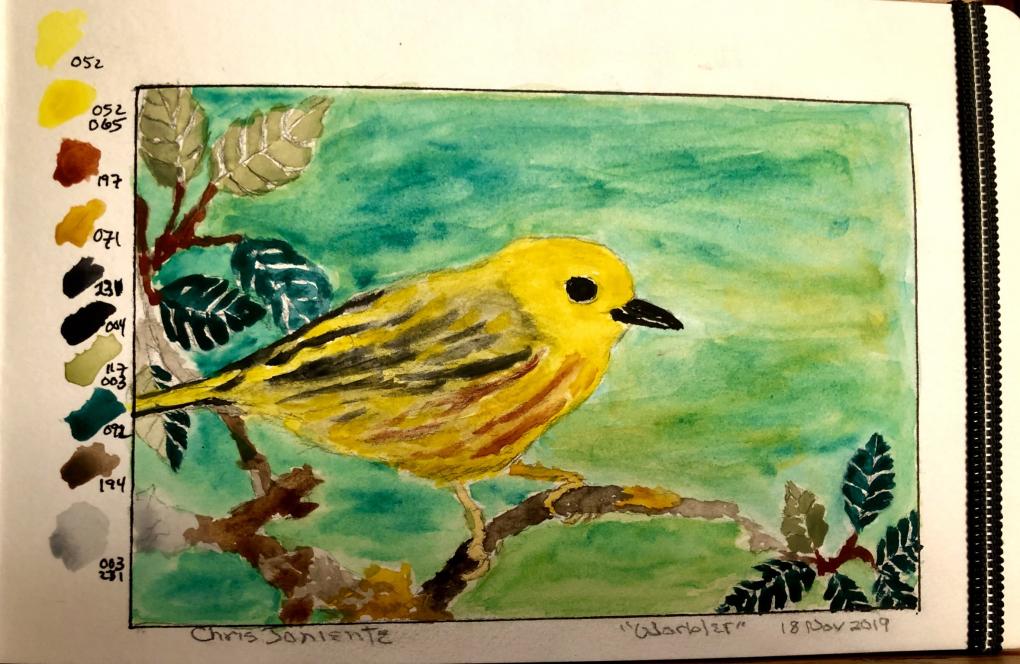 I hope to be more precise in painting those details though. It will be interesting to try this again at the end of the course.
I hope to be more precise in painting those details though. It will be interesting to try this again at the end of the course.
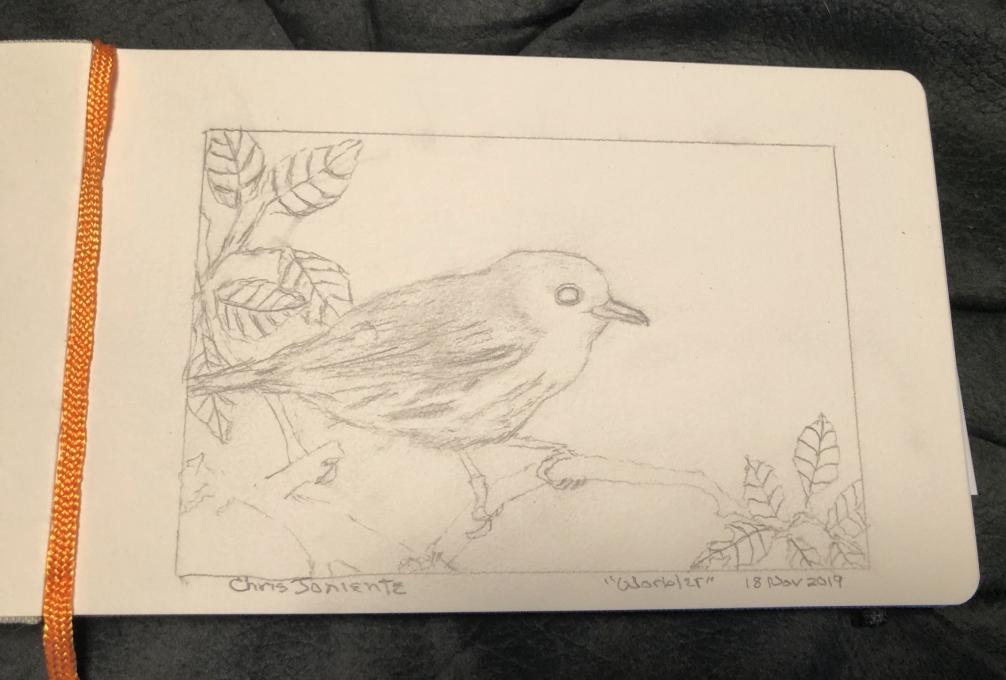
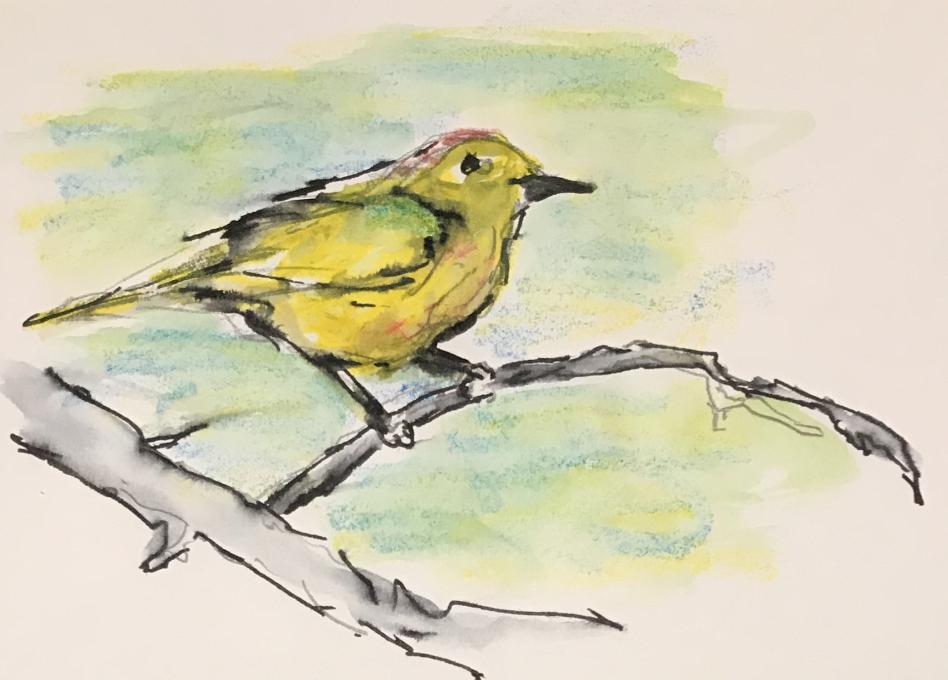



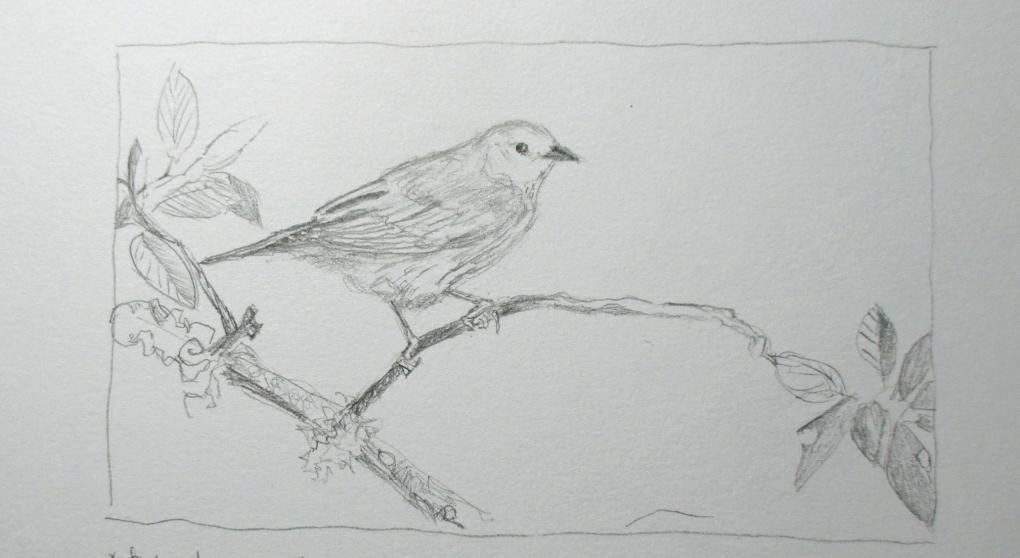 The bird's beauty and expression makes it easy to connect through the eyes down through the hand and pencil. What I learned and appreciated from drawing: the wing structure -- the layers of different feathers that make up the wing.
The bird's beauty and expression makes it easy to connect through the eyes down through the hand and pencil. What I learned and appreciated from drawing: the wing structure -- the layers of different feathers that make up the wing. 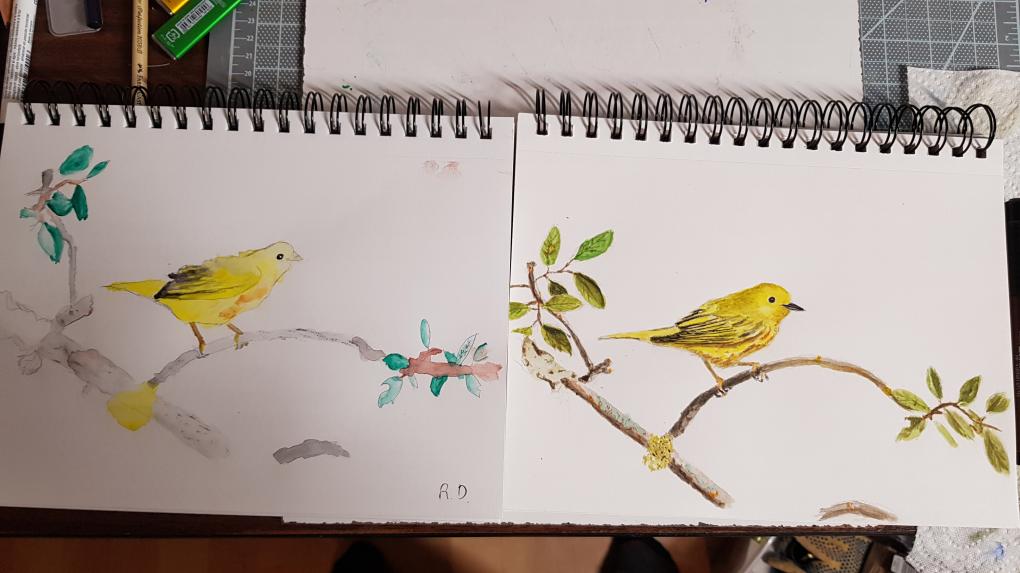 My daughter and I are doing this course together...looks like we forgot to answer the questions, but we did discuss them.
Drawing from a photo is much easier since it's not going to fly away any second;-) My daughter says the branch was the easy part. I find proportions are always challenging for me. We both noticed that by drawing/painting your subject that you become more familiar to it and notice more details. I think that you become more connected to it and more concerned about its welfare as well. So, nature journaling can make a significant different in how you see and interact with the world around you.
My daughter and I are doing this course together...looks like we forgot to answer the questions, but we did discuss them.
Drawing from a photo is much easier since it's not going to fly away any second;-) My daughter says the branch was the easy part. I find proportions are always challenging for me. We both noticed that by drawing/painting your subject that you become more familiar to it and notice more details. I think that you become more connected to it and more concerned about its welfare as well. So, nature journaling can make a significant different in how you see and interact with the world around you.  Hi all
Finally sat down to get started and tried to focus on shape and key features rather than stressing too much about precision. Quite pleased with how this turned out after maybe 30 minutes work given I have no art background and haven't sketched anything since high school about 30 years ago!
Hi all
Finally sat down to get started and tried to focus on shape and key features rather than stressing too much about precision. Quite pleased with how this turned out after maybe 30 minutes work given I have no art background and haven't sketched anything since high school about 30 years ago! 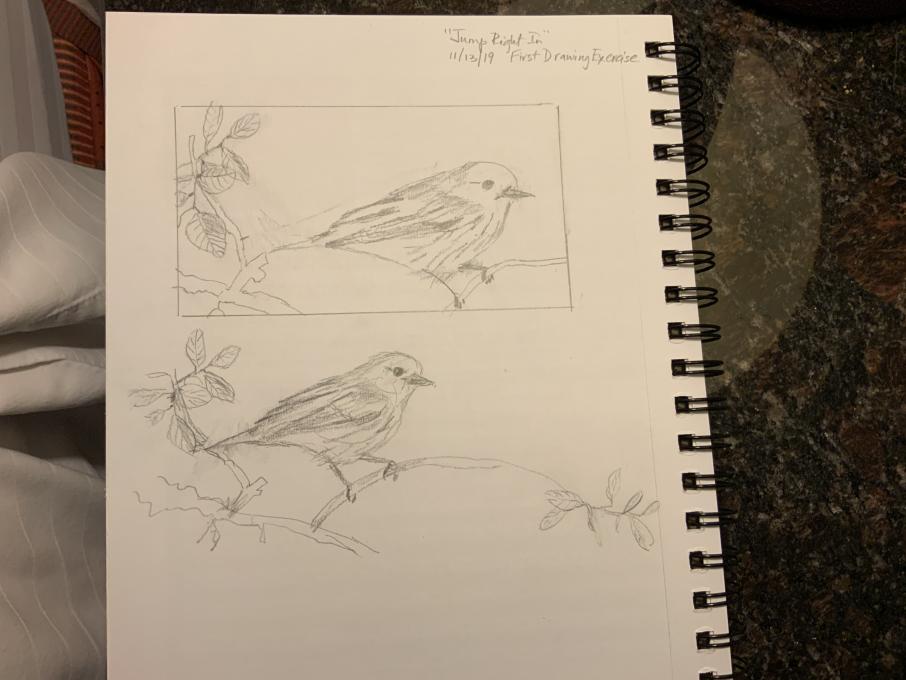
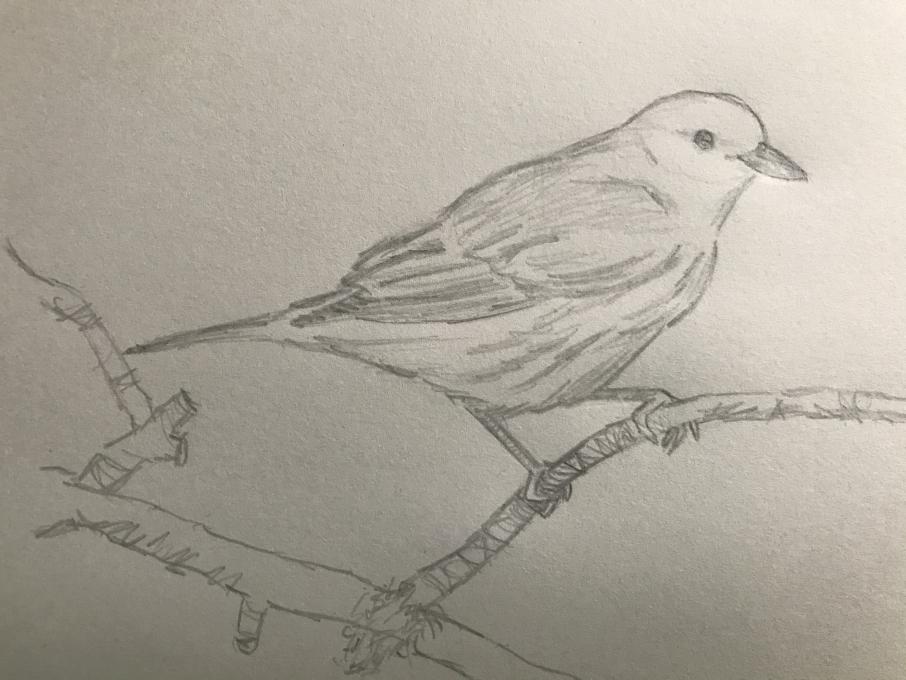 Spent days psyching myself up to do the drawing. Haven't put pencil to paper in years. Hoping this course motivates me. Looking forward to working with color. Have only ever used pencil. Have always been fascinated by drawings done by naturalists on expeditions of discovery centuries ago. Looking forward to learning how to work from nature.
Spent days psyching myself up to do the drawing. Haven't put pencil to paper in years. Hoping this course motivates me. Looking forward to working with color. Have only ever used pencil. Have always been fascinated by drawings done by naturalists on expeditions of discovery centuries ago. Looking forward to learning how to work from nature. 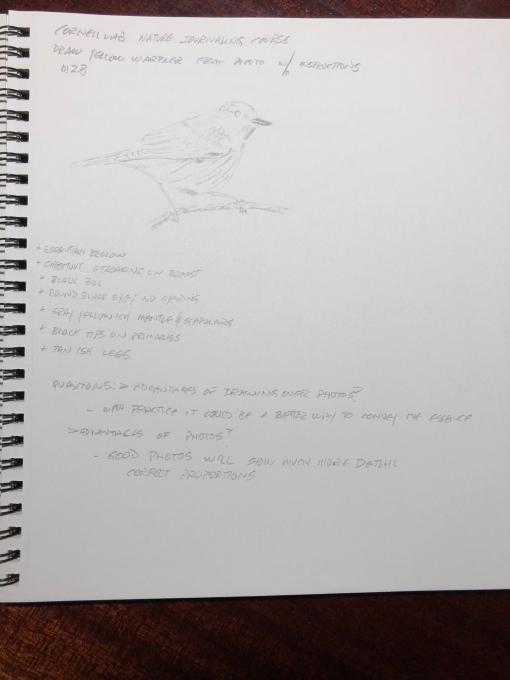 A good photograph will capture much more feather detail and color than a drawing; the proportions are right as well. This assumes, of course, good light, no awkward angles etc.
A good photograph will capture much more feather detail and color than a drawing; the proportions are right as well. This assumes, of course, good light, no awkward angles etc. 
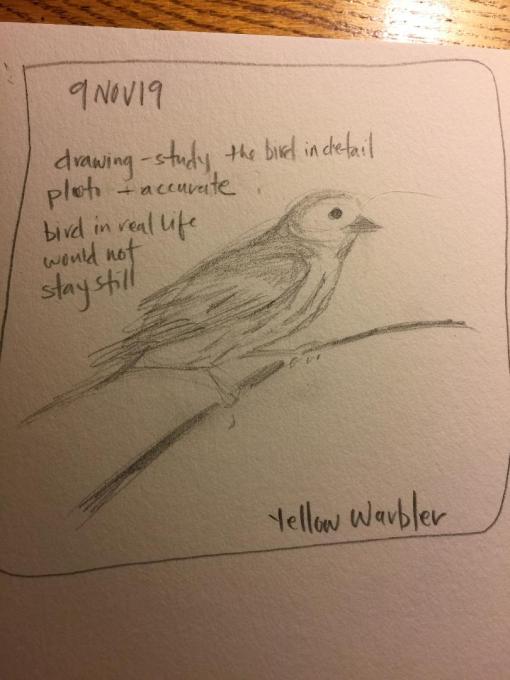 Can't wait to see my "after" drawing! This exercise did motivate me to read more about yellow warblers and study other photos/drawings.
Can't wait to see my "after" drawing! This exercise did motivate me to read more about yellow warblers and study other photos/drawings. 